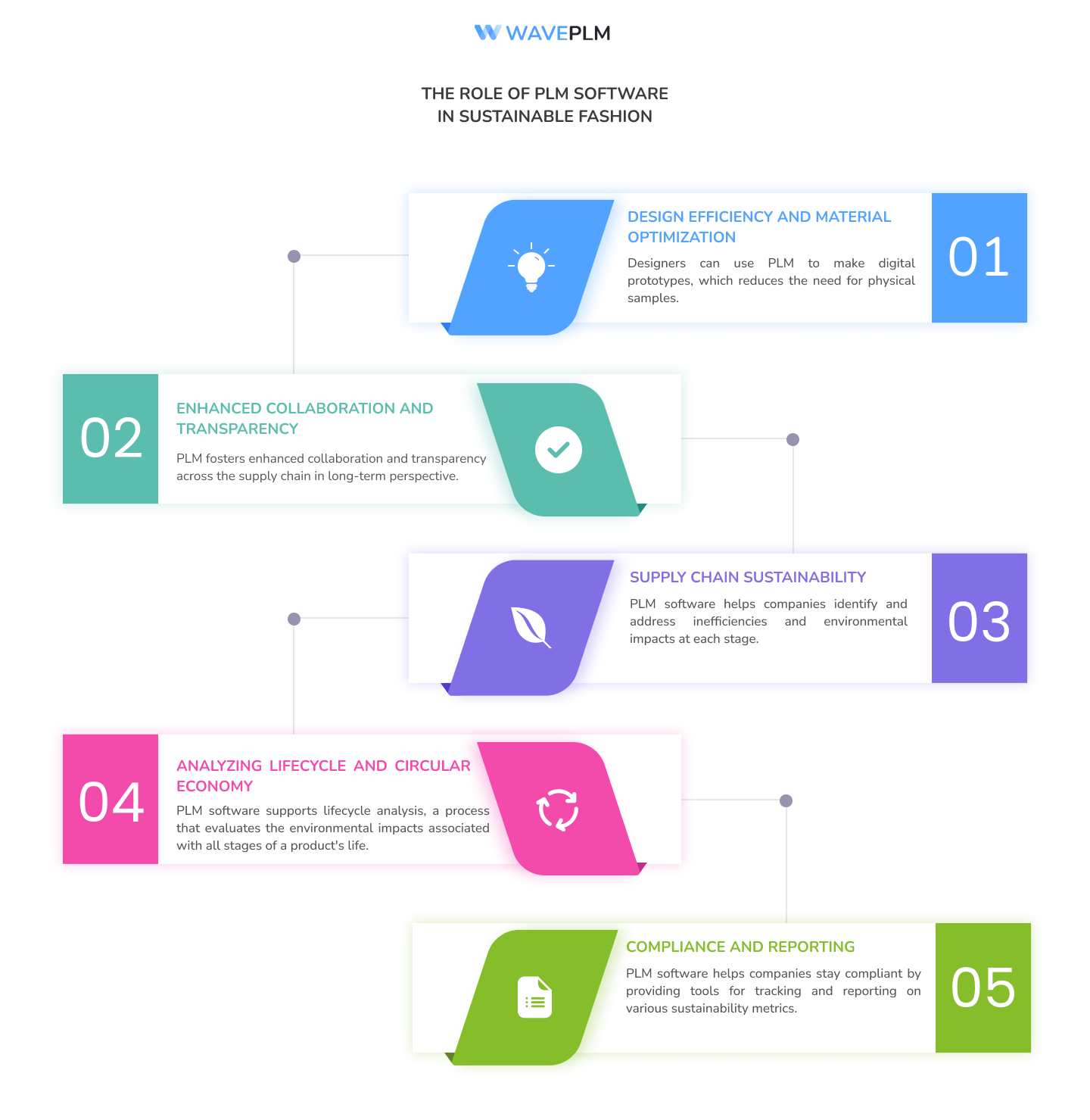
Today, fashion must be more environmentally friendly to be sustainable in the modern world. Consumers, regulatory bodies, and environmental advocates are calling for transparency, ethical production, and a significant reduction in the environmental impact of fashion.
As a response, companies are turning to Product Lifecycle Management (PLM) software like Wave PLM to revolutionize their processes. This article explores how fashion PLM software drives sustainable innovation, improves supply chain sustainability, and encourages the use of sustainable materials.
Understanding PLM Software
Product Lifecycle Management (PLM) software is a strategic tool that manages the entire lifecycle of a product from inception, through design and manufacturing, to service and disposal. It integrates people, data, processes, and business systems and provides a product information backbone for companies. This integration facilitates informed decision-making and seamless collaboration among different departments, leading to more efficient and sustainable operations.
The Role of PLM Software in Sustainable Fashion
1. Design Efficiency and Material Optimization
One of the most significant ways PLM software supports sustainable fashion is through design efficiency and material optimization. Designers can use PLM tools to make digital prototypes, which reduces the need for physical samples and helps save natural resources. By simulating various materials and design iterations in a virtual environment, designers can identify the most sustainable options early in the product development process.
Moreover, PLM software enables designers to access a library of sustainable materials, like deadstock fabric complete with detailed information about their environmental impact. This accessibility encourages the use of eco-friendly materials, reducing the reliance on traditional, more harmful raw material alternatives.

2. Enhanced Collaboration and Transparency
PLM software fosters enhanced collaboration and transparency across the supply chain in long-term perspective. All stakeholders, from designers to manufacturers, can access real-time data about the product’s lifecycle. This transparency ensures that every step of the production process adheres to the company’s sustainability goals.
For instance, a designer in New York can collaborate with a manufacturer in Bangladesh in real-time, ensuring that sustainable practices are followed throughout the production process. This level of collaboration minimizes errors and inefficiencies, reducing waste and energy consumption.
3. Supply Chain Sustainability
Supply chain sustainability is a critical aspect of sustainable innovation in the fashion industry. PLM software plays a pivotal role in enhancing supply chain transparency and efficiency. By providing a comprehensive view of the supply chain, PLM software helps companies identify and address inefficiencies and environmental impacts at each stage.
- Sourcing Sustainable Materials
PLM software allows companies to source sustainable materials more effectively. With access to a vast database of suppliers and materials, companies can evaluate the sustainability credentials of potential suppliers. This capability ensures that only the most sustainable materials are used in production, significantly reducing the environmental footprint of the final product.
- Tracking and Reducing Carbon Footprint
PLM software enables companies to track their carbon footprint throughout the supply chain. By analyzing data on energy usage, transportation emissions, and waste generation, companies can identify areas where they can reduce their carbon footprint, including greenhouse gas emissions. This proactive approach not only supports environmental goals but also enhances the company’s reputation among eco-conscious consumers.
- Ethical Production Practices
Ensuring ethical production practices is another crucial aspect of supply chain sustainability. PLM software provides tools to monitor labor practices, working conditions, and compliance with regulations like UFLPA. This monitoring capability helps companies ensure that their supply chain partners adhere to ethical and sustainable practices, thereby promoting a more responsible fashion industry.
4. Analyzing Lifecycle and Circular Economy
PLM software supports lifecycle analysis, a process that evaluates the environmental impacts associated with all stages of a product’s life. By conducting a thorough lifecycle analysis, companies can identify opportunities to reduce environmental impact and implement more sustainable practices.
- Designing for Durability
One of the key insights gained from lifecycle analysis is the importance of designing for durability. PLM software allows designers to test the durability of different materials and designs, ensuring that the final product is long-lasting. Designing durable products reduces the need for frequent replacements, thereby minimizing waste.
- Facilitating the Circular Economy
The circular economy is an economic system aimed at eliminating waste and the continual use of resources. PLM software plays a crucial role in facilitating the circular economy by enabling companies to design products that can be easily disassembled, recycled, or repurposed at the end of their life. This approach reduces the reliance on virgin materials and minimizes waste, promoting more sustainable energy efficiency in the fashion industry.
5. Compliance and Reporting
Compliance with environmental regulations is essential for companies committed to sustainability. PLM software helps companies stay compliant by providing tools for tracking and reporting on various sustainability metrics. This capability ensures that companies meet regulatory requirements and can demonstrate their commitment to sustainability to stakeholders.
- Monitoring Regulatory Changes
The regulatory landscape for environmental sustainability is constantly evolving. PLM software helps companies stay ahead of these changes by providing updates on new regulations and guidelines. This proactive approach ensures that companies remain compliant and avoid potential fines or reputational damage.
- Sustainability Reporting
Transparent sustainability reporting is crucial for building trust with consumers and stakeholders. PLM software facilitates the collection and analysis of data required for sustainability reporting. Companies can generate detailed reports on their environmental impact, including metrics such as carbon emissions, water usage, and waste generation. These reports provide valuable insights for continuous improvement and demonstrate the company’s commitment to sustainability.

Case Studies: PLM Software in Action
- Adidas: Innovating with Sustainable Materials and Processes
Adidas, a sportswear giant, uses PLM software to drive sustainable innovation with eco-friendly materials and processes. The company has integrated PLM tools into its design and development workflows, enabling designers to access a comprehensive library of eco-friendly materials. This approach has facilitated the creation of products such as the Adidas Futurecraft Loop, a 100% recyclable running shoe.

Adidas also uses PLM software to enhance supply chain transparency and ensure ethical production practices. By monitoring supplier compliance and working conditions, Adidas maintains high ethical standards throughout its supply chain, promoting sustainability at every stage of the product lifecycle.
- Levi Strauss & Co.: Enhancing Supply Chain Transparency
Levi Strauss & Co. has implemented PLM software to enhance supply chain transparency and sustainability. The company uses PLM tools to track the environmental impact of its products from design to disposal. This comprehensive approach allows Levi Strauss & Co. to identify and address inefficiencies, reducing waste and emissions.

One notable initiative is the company’s Water<Less™ program, which reduces water usage in the manufacturing process. PLM software supports this initiative by providing data on water consumption and identifying opportunities for further reductions.
Challenges and Future Directions
While PLM software offers significant benefits for sustainable fashion, there are challenges to consider. Implementing PLM systems can be resource-intensive, requiring significant investment in technology and training. Additionally, integrating PLM software with existing systems and processes can be complex.
However, the future of PLM software in supporting sustainable innovation looks promising. Advances in technology, such as artificial intelligence and blockchain, are expected to enhance the capabilities of PLM tools. For instance, AI can improve material optimization and design efficiency, while blockchain can provide even greater transparency and traceability in the supply chain.
Conclusion
PLM software is a powerful tool for driving sustainable innovation in the fashion industry. By enhancing design efficiency, promoting the use of sustainable materials, and improving supply chain transparency, PLM tools support eco-friendly practices and help companies meet their sustainability goals. As the fashion industry continues to evolve, PLM software will play an increasingly important role in promoting a more sustainable and ethical future with a huge impact on the environment.
Embracing PLM software not only aligns with environmental and ethical values but also positions companies to meet the growing demand for sustainable fashion like cost saving. As consumers become more conscious of their purchasing choices, the integration of PLM software in fashion operations is no longer a luxury but a necessity for companies committed to sustainability. By investing in PLM technology, fashion brands can lead the way in creating a more sustainable and responsible industry, ensuring a better future for the planet and its inhabitants.





Leave a Reply